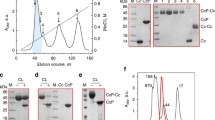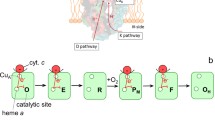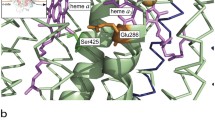Abstract
The kinetics of reduction of horse heart cytochrome c have been investigated using the reductants sodium dithionite and potassium ferrocyanide. Sodium dithionite reduction at pH 7.0 yields rate constants of 2.8×108M−1sec−1 for SO −2 and 6×105M−1sec−1 for S2O =4 at infinite dilution. Moreover,the data presented demonstrates the participation of positively charged amino acid side chains at the site of electron transfer. The effect of pH on the reduction of ferricytochrome c requires a minimum of two pK Values for description (pK1=7.0±0.4,pK2=9.3±0.3). Based on the pK values determined, one or more lysines and a residue(s) with a low pK are implicated as the positively charged residues participating in electron transfer. From a comparison of the rates of reduction of various denatured forms of cytochrome c we feel that the most viable conclusion is that electron transfer takes place at the exposed heme edge in the vicinity of the amino acid side chains indicated above.
Ferrocyanide reduction of ferri-horse heart cytochrome c takes place in a kinetically complex manner. A mechanism is described which includes complexes of ferrocyanide and ferricytochrome c and ferricyanide and ferrocytochrome c. As was found for dithionite reduction a positively charged region of the cytochrome c participates in electron transfer. Combining our results with ferrocyanide and dithionite we conclude that available data is compatible with a single mechanism of electron transfer. It is suggested that the kinetic distinction between different reductants lies in the lifetime of the transient complex formed, with the order ferrocyanide≫ S2O =4 >SO −2 .
Similar content being viewed by others
References
Bartsch, R. G., Horio, T., Kamen, M. D.: Preparation and properties of Rhodospirillum rubrum cytochromes c2, cc′, and b557.4, and flavin mononucleotide protein. J. biol. Chem. 246, 4489–4496 (1971)
Brandt, K. G., Parks, P. C., Czerlinski, G. H., Hess, G. P.: On the elucidation of the pH dependence of the oxidation-reduction potential of cytochrome c at alkaline pH. J. biol. Chem. 241, 4180–4185 (1966)
Burlamacchi, L., Casini, G., Fagioli, O., Tiezzi, E.: Studio E. P. R. sulla dissoclazione dello ione dithionito in soluzione acquosa. Ric. Sci. 34, 97–101 (1967)
Corradin, G., Harbury, H. A.: Reconstitution of horse heart cytochrome C: interaction of the components obtained upon cleavage of the peptide bond following methionine residue 65. Proc. nat. Acad. Sci. (Wash.) 68, 3036–3039 (1971)
Creutz, C., Sutin, N.: Reduction of ferricytochrome c by dithionite ion: electron transfer by parallel adjacent and remote pathways. Proc. nat. Acad. Sci. (Wash.) 70, 1701–1703 (1973)
Czerlinski, G., Bracokova, V.: Kinetics and equilibria among multiple forms of ferricytochrome c. Biochim. biophys. Acta (Amst.) 275, 480–489 (1973)
Dawson, J. W., Gray, H. B., Holwerda, R. A., Westhead, E. W.: Kinetics of the reduction of metalloproteins by chromous ion. Proc. Nat. Acad. Sci. (Wash.) 69, 30–33 (1972)
Dickerson, R. E., Takano, T., Eisenberg, D., Kallai, O. B., Samson, L., Cooper, A., Margoliash, E.: Ferricytochrome c. I. General features of the horse and bonito proteins at 2.8å resolution. J. biol. Chem. 246, 1511–1535 (1971)
Frost, A. A., Pearson, R. G.: Kinetics and mechanism. New York: Wiley 1961
Greenwood, C., Palmer, G.: Evidence for the existence of two functionally distinct forms of cytochrome c monomer at alkaline pH. J. biol. Chem. 240, 3660–3663 (1965)
Havsteen, B. H.: Kinetic studies of the interaction of ferricytochrome c with potassium ferrocyanide by a chemical relaxation technique. Acta chem. scand. 19, 1227–1231 (1965)
Jori, G., Gennari, G., Folin, M., Galiazzo, G.: Probing the topography of proteins in solution by photosensitized oxidation. The heme environment in horse heart ferrocytochrome c. Biochim. biophys. Acta (Amst.) 229, 525–528 (1971)
Kowalsky, A.: A study of the mechanism of electron transfer in cytochrome c: Chromium as a probe. J. biol. Chem. 244, 6619–6625 (1969)
Lambeth, D. O., Palmer, G.: The kinetics and mechanism of reduction of electron transfer proteins and other compounds of biological interest by dithionite. J. biol. Chem. 248, 6095–6103 (1973)
Lambeth, D. O., Campbell, K. L., Zand, R., Palmer, G.: The appearance of transient species of cytochrome c upon rapid oxidation or reduction at alkaline pH. J. biol. Chem. 248, 8130–8136 (1973)
Land, E. J., Swallow, A. J.: One-electron reactions in biochemical systems as studied by pulse radiolysis: V. Cytochrome c. Arch. Biochem. Biophys. 145, 365–372 (1971)
Lichtin, N., Shufferman, A., Stein, G.: Reaction of cytochrome c with one-electron redox reagents. I. Reduction of ferricytochrome c by the hydrated electron produced by pulse radiolysis. Biochim. biophys. Acta (Amst.) 314, 117–135 (1973)
Lynn, S., Rinker, R. G., Corcoran, W. H.: The monomerization rate of dithionite ion in aqueous solution. J. Phys. Chem. 68, 2363 (1964)
Margoliash, E., Barlow, G. H., Byers, V.: Differential binding properties of cytochrome c: possible relevance for mitochondrial ion transport. Nature (Lond.) 228, 723–726 (1970)
Margoliash, E., Ferguson-Miller, S., Tulloss, J., Kang, G. H., Feinberg, B. A., Brautigan, D. L., Morrison, M.: Separate intramolecular pathways for reduction and oxidation of cytochrome c in electron transport chain reactions. Proc. nat. Acad. Sci. (Wash.) 70, 3245–3249 (1973)
Matsubara, H., Smith, E. C.: Human heart cytochrome c: chymotryptic peptides, tryptic peptides, and the complete amino acid sequence. J. biol. Chem. 238, 2732–2752 (1963)
Meyer, T. E.: Comparative studies on soluble iron-containing proteins in photosynthetic bacteria and some algae. Ph. D. Thesis, University of California at San Diego 1970
Meyer, T. E., Bartsch, R. G., Kamen, M. D.: Cytochrome c3. A class of electron transfer heme proteins found in both photosynthetic and sulfate-reducing bacteria. Biochim. biophys. Acta (Amst.) 245, 453–464 (1971)
Pecht, I., Faraggi, M.: The reduction of cytochrome c by hydrated electrons. FEBS Letters 13, 221–223 (1971)
Salemme, F. R., Kraut, J., Kamen, M. D.: Structural bases for function in cytochromes c: an interpretation of comparative X-ray and biochemical data. J. biol. Chem. 248, 7701–7716 (1973)
Stellwagen, E., Shulman, R. G.: Nuclear magnetic resonance study of the rate of electron transfer between cytochrome c and iron hexacyanides. J. molec. Biol. 80, 559–573 (1973)
Sutin, N., Christman, D. R.: The rate of oxidation of cytochrome c by ferricyanide ions. J. Amer. chem. Soc. 83, 1773–1774 (1961)
William, G. R.: The reduction of cytochrome c by hydroquinone. Canad. J. Biochem. 41, 231–237 (1963)
Wilson, M. T., Greenwood, C.: Studies on ferricytochrome c: 2. A correlation between reductibility and the possession of the 695 nm absorption band of ferricytochrome c. Europ. J. Biochem. 22, 11–18 (1971)
Wilting, J., Braams, R., Nauta, H., Van Buren, K. J. H.: The reduction mechanism of ferricytochrome c. Biochim. biophys. Acta (Amst.) 238, 543–547 (1972)
Yandell, J. K., Fay, D. P., Sutin, N.: Mechanisms of the reactions of cytochrome c. II. The rate of reduction of horse heart ferricytochrome c by chromium (II). J. Amer. chem. Soc. 95, 1131–1137 (1973)
Author information
Authors and Affiliations
Rights and permissions
About this article
Cite this article
Greg Miller, W., Cusanovich, M.A. Electron transport by C-type cytochromes. Biophys. Struct. Mechanism 1, 97–111 (1975). https://doi.org/10.1007/BF00539772
Received:
Issue Date:
DOI: https://doi.org/10.1007/BF00539772




